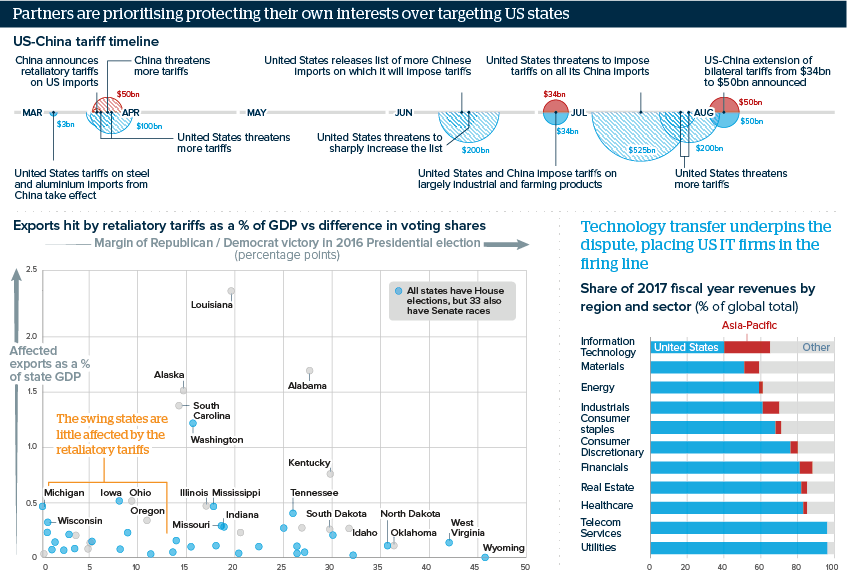Tariffs will test not reconfigure global supply chains
The United States and China are imposing tariffs on over 50 billion dollars of the other’s imports -- and threaten more
Source: US Chamber of Commerce, US Bureau of Economic Analysis, Goldman Sachs, company reports, 2016 presidential election results, Oxford Analytica
Outlook
The US administration plans to extend the tariffs to 200 billion dollars or 40% of its Chinese imports next month. US tariffs of 25% will cover 16 billion dollars more Chinese imports from August 23 and China will match the tariffs.
China is protecting its role in global supply chains by tailoring its tariffs to the ease of substitution. Chinese tariffs on aircraft and some electronic parts will be 5% as more than 50% of China’s imports of these come from the United States. Substitutable US imports including textiles and lower value electronics face 25% tariffs.
China’s subtle response demonstrates that each side is prepared for the tariffs continuing into 2019.
Impacts
- China will tax US imports of liquified natural gas at 25% -- but compromise could come in this sensitive sector.
- The ‘Made in China 2025’ initiative could be tweaked -- subsidising research more might appease US tech transfer worries.
- China’s People’s Daily suggests US firms reliant on China could find ways of sharing profit in China to boost relations.
- Both can cope with higher trade costs; tariffs on all bilateral goods trade involve less than 5% of either countries’ GDP.
- Reshoring US industry, especially electronics, will take decades; many subsectors are so integrated it will be impossible.
See also
- Ease of substitution drives the US-China tariff agenda - Aug 14, 2019
- Extended tariffs may push a US-China deal beyond 2020 - Aug 13, 2019
- Prospects for the global economy to end-2019 - Jun 28, 2019
- US-China trade deal and tariff removal will recede - May 14, 2019
- More sanctions support US interests but not activity - Jan 30, 2019
- Prospects for African economies in 2019 - Nov 23, 2018
- US tariffs and trade confusion to persist post polls - Oct 24, 2018
- China's near-term focus will accelerate slower growth - Oct 23, 2018
- EU-US economic ties will survive testing US policies - Oct 8, 2018
- US-China tariff trouble may dampen investment globally - Sep 24, 2018
- US-China agreement is still possible amid acrimony - Sep 18, 2018
- NAFTA moves imply more US-China trade conflict - Sep 3, 2018
- US goods gap is ballooning despite policy intentions - Aug 29, 2018
- Taxes offer an alternative to tariffs - Aug 29, 2018
- US-China talks signpost more tariffs and talks ahead - Aug 24, 2018
- Asia-centred trade pacts will proceed with weaknesses - Aug 24, 2018
- US/China self-sufficiency drives could cut world GDP - Apr 4, 2018
- More graphic analysis
